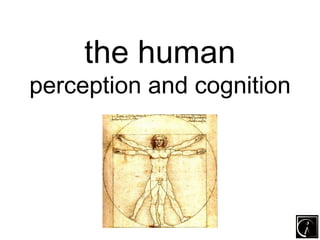
The Human perception & Overview
- 1. the human perception and cognition
- 2. computational analogy input processing output perception cognition action (thinking and memory) (motor system)
- 3. a cycle of interaction cognition perception action the world
- 4. perception
- 5. ‘the’ five senses sight distant sound complex smell closer pain, temperature, pressure, texture touch contact largely taste inside! smell!
- 6. ‘the’ five senses sight sound not the whole smell story touch taste
- 7. outside and within exteroception interoception sight, sound, headaches, smell, touch, hunger, taste proprioception sensing the sensing the outside inside
- 8. outside and within exteroception interoception sight, sight, sound, headaches, smell, most used sense in interfaces touch, hunger, taste (e.g. retina displays!) proprioception sensing the half the brain around sensing the dedicated to vision outside inside
- 9. sight and sound in short
- 10. the eye(s) and vision on the front iris & pupil (lens) – adjust light level and focus two of them – 3D vision – but not the only way at the back fovea – detailed and colour ... but very small, peripheral vision – b&w, movement, grabs attention inside two pathways – fast, old, unconscious + slower, newer, conscious
- 11. the ears and sound inherently temporal no ‘still’ sound => issues for media two of them & pinna directional ... stereo & full 3D little physical focus, but ... attention – cocktail part effect background – context and grab attention
- 12. eye & ear ... common attention – focus limited construction filling ga meaning grabbing attention periphery – context, broader, but unconscious
- 14. memory in short
- 15. types of memory timescale seconds sensory memory short-term memory (STM) minutes mezzanine memory hours/days lifetime long-term memory (LTM)
- 16. comparison short term long term mezzanine capacity 7+/-2 chunks big! ? decay ~30s lifetime ? mins–hours needs rehearsal laying down implicit repetition implicit neural electrical physical chemical? mechanism neuron firing synapse growth LTP
- 17. types of LTM episodic serial memory of events may be hard to recall out of order => story and narrative semantic / declarative facts, concepts, skills links and associations => recognition vs recall http://en.wikipedia.org/wiki/File:The_Tyger_BM_a_1794.j
- 18. semantic not photographic perception encode reconstruct memories all memories are constructed confabulation, false memories
- 19. mezzanine memory what have I been doing recently? short-term episodic memory what am I doing now? context – activates LTM cockpits and control rooms situation awareness reading long-term working memory http://en.wikipedia.org/wiki/File:Swiss_Saab_2000_Cockpit.jpg
- 20. implicit / tacit as well as explicit automatic reactions motor memories expert knowledge proceduralisation activation & context implicit explicit introspection & externalisation http://www.flickr.com/photos/protographer23/358987856/
- 21. thinking
- 22. logical? Aristotle & formal logic all men are mortal Socrates is a man => Socrates is mortal Wason card test possible rule: vowel one side ⇒even on other is it right? E 7 K 2 3 4 U P A Z
- 23. reasoning – the real world confirmationnot falsification abductionnot deduction satisficingnot optimality
- 24. special purpose intelligence Wason rule: vowel one side ⇒even on other E 7 K 2 social social rule: take newspaper ⇒pay for it rule: take newspaper ⇒pay for it no paper no £ paper £
- 25. below the surface linear – single ‘stream of conscious consciousness’ interruptions = disruptions multitasking – really rapid switching priming, insight unconscious non-linear, fuzzy, intuitive, associative share with animals
- 26. into action and into the world
- 27. we live to act cognition perception action the world
- 28. low level automatic reactions innate and learnt e.g. heat reflex hand–eye coordination Fitts’ Law: s time ~ log (distance/size) d
- 29. perception and action single stream of consciousness attention single stream of activity grabbing attention often physical movement periphery feeds unconsciousness associations
- 30. higher level longer–term conscious planning and activity moment-to-moment Norman’s execution evaluation cycle user establishes the goal formulates intention specifies actions at interface goal executes action execution evaluation perceives system state interprets system state system evaluates system state with respect to goal
- 31. Human error - slips and mistakes slip understand system and goal correct formulation of action incorrect action mistake may not even have right goal! Fixing things? slip – better interface design mistake – better understanding of system
- 32. all in the mind? reminders, lists, notes, workings we think using the world distributed cognition situated action extended mind
Notes de l'éditeur
- brain image: CC. Patrick J. Lynch, http://en.wikipedia.org/w/index.php?title=File:Skull_and_brain_normal_human.svg&page=1
- http://en.wikipedia.org/wiki/File:Descartes-reflex.JPG